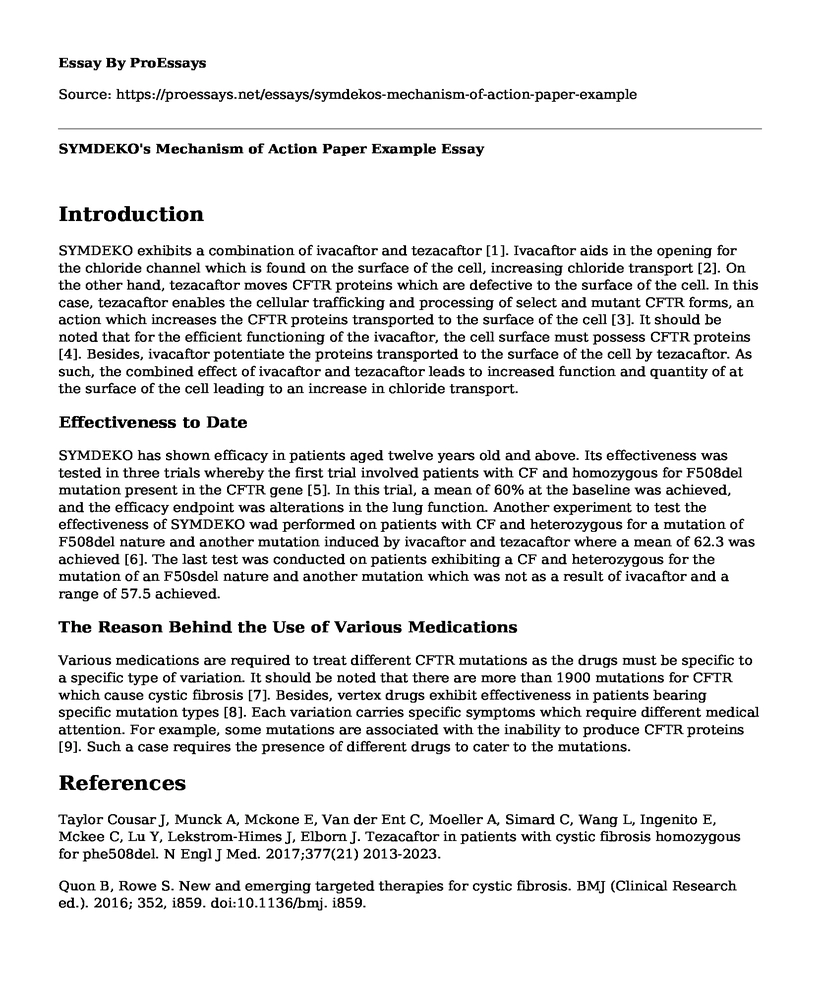Introduction
SYMDEKO exhibits a combination of ivacaftor and tezacaftor [1]. Ivacaftor aids in the opening for the chloride channel which is found on the surface of the cell, increasing chloride transport [2]. On the other hand, tezacaftor moves CFTR proteins which are defective to the surface of the cell. In this case, tezacaftor enables the cellular trafficking and processing of select and mutant CFTR forms, an action which increases the CFTR proteins transported to the surface of the cell [3]. It should be noted that for the efficient functioning of the ivacaftor, the cell surface must possess CFTR proteins [4]. Besides, ivacaftor potentiate the proteins transported to the surface of the cell by tezacaftor. As such, the combined effect of ivacaftor and tezacaftor leads to increased function and quantity of at the surface of the cell leading to an increase in chloride transport.
Effectiveness to Date
SYMDEKO has shown efficacy in patients aged twelve years old and above. Its effectiveness was tested in three trials whereby the first trial involved patients with CF and homozygous for F508del mutation present in the CFTR gene [5]. In this trial, a mean of 60% at the baseline was achieved, and the efficacy endpoint was alterations in the lung function. Another experiment to test the effectiveness of SYMDEKO wad performed on patients with CF and heterozygous for a mutation of F508del nature and another mutation induced by ivacaftor and tezacaftor where a mean of 62.3 was achieved [6]. The last test was conducted on patients exhibiting a CF and heterozygous for the mutation of an F50sdel nature and another mutation which was not as a result of ivacaftor and a range of 57.5 achieved.
The Reason Behind the Use of Various Medications
Various medications are required to treat different CFTR mutations as the drugs must be specific to a specific type of variation. It should be noted that there are more than 1900 mutations for CFTR which cause cystic fibrosis [7]. Besides, vertex drugs exhibit effectiveness in patients bearing specific mutation types [8]. Each variation carries specific symptoms which require different medical attention. For example, some mutations are associated with the inability to produce CFTR proteins [9]. Such a case requires the presence of different drugs to cater to the mutations.
References
Taylor Cousar J, Munck A, Mckone E, Van der Ent C, Moeller A, Simard C, Wang L, Ingenito E, Mckee C, Lu Y, Lekstrom-Himes J, Elborn J. Tezacaftor in patients with cystic fibrosis homozygous for phe508del. N Engl J Med. 2017;377(21) 2013-2023.
Quon B, Rowe S. New and emerging targeted therapies for cystic fibrosis. BMJ (Clinical Research ed.). 2016; 352, i859. doi:10.1136/bmj. i859.
Donaldson S, Pilewski J, Griese M, Cooke J, Viswanathan L, Tullis E, Davies J, Lekstrom-Himes J, Wang L, VX11-661-101 Study Group. Tezacaftor/Ivacaftor in Subjects with Cystic Fibrosis and F508del/F508del-CFTR or F508del/G551D-CFTR. American Journal of Respiratory and Critical Care Medicine. 2018; 197(2), 214-224.
Brodlie M, Haq I, Roberts K, Elborn S. Targeted therapies to improve CFTR function in cystic fibrosis. Genome Medicine. 2015; 7, 101. doi:10.1186/s13073-015-0223-6.
Flume P, Liou T, Borowitz D, Li H, Yen K, Ordonez C, Geller D, VX 08-770-104 Study Group. Ivacaftor in subjects with cystic fibrosis who are homozygous for the F508del-CFTR mutation. Chest. 2012; 142(3), 718-724.
Rowe S, Daines C, Rinshausen F, Kerem E, Wilson J, Tullis E., Nair N., Simard C, Han L, Ingenito E, Mckee C, Lekstrom-Himes J & Davies J. Tezacaftor-ivacaftor in residual-function heterozygotes with cystic fibrosis. N Engl J Med. 2017; 377(21): 2024-2035.
Maiuri L, De Stefano D., Raia V, Kroemer G. The holy grail of cystic fibrosis research: pharmacological repair of the F508del-CFTR mutation. Annals of translational medicine. 2015; 3(Suppl 1), S24.
Pettit R, Fellner C. (2014). CFTR Modulators for the Treatment of Cystic Fibrosis. P & T: A Peer-Reviewed Journal for Formulary Management. 2014. 39(7), 500-11.
Hull J. Cystic fibrosis transmembrane conductance regulator dysfunction and its treatment. Journal of the Royal Society of Medicine. 2012;105 Suppl 2(Suppl 2), S2-8.
Cite this page
SYMDEKO's Mechanism of Action Paper Example. (2022, Oct 23). Retrieved from https://proessays.net/essays/symdekos-mechanism-of-action-paper-example
If you are the original author of this essay and no longer wish to have it published on the ProEssays website, please click below to request its removal:
- Testicular Cancer Case Study
- Responses on Nursing Profession and Social Work
- Foundation of Medicine County Herbs Apothecary
- Essay Sample on 24/7 Society: Health Consequences for Night Shift Workers
- Paper Example on Treating Alzheimer's Dementia: Mr. Akkad's Case
- Nuts Intake & Cardiovascular Mortality: A Global Perspective - Essay Sample
- EHR: Enhancing Clinicians-Patients Bond - Report Sample







